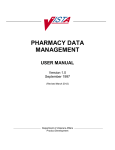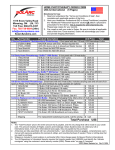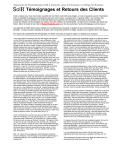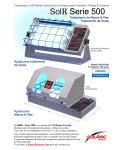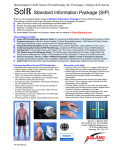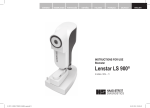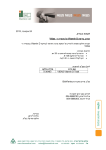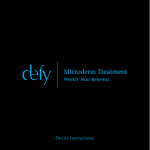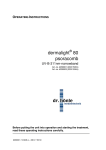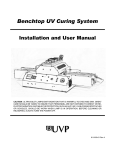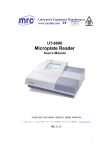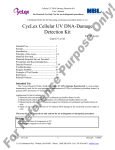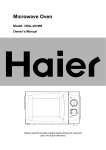Download Vitamin-D User`s Manual Supplement
Transcript
Vitamin-D User's Manual Supplement For use with all Solarc/SolRx UVB-Narrowband (UVB-NB) and UVB-Broadband (UVB) Phototherapy Devices E-Series, 1000-Series, 500-Series, 100-Series Solarc Systems Inc. 1515 Snow Valley Road, Minesing, ON L0L 1Y3 CANADA Toll Free Phone: 866-813-3357 (705-739-8279) Fax: 705-739-9684 Email: [email protected] Web: SolarcSystems.com WARNING: This User's Manual Supplement must be used in conjunction with the User's Manual provided with the SolRx device. WARNING: Read and understand this User's Manual in its entirety before using the equipment. If you have questions, consult your physician or call Solarc Systems toll free: 866-813-3357 (705-739-8279). WARNING: Use of this equipment must be accompanied by physician examination at least once per year; this is a condition of sale. Ce manuel d'utilisation est également disponible en français. ©Solarc Systems Inc. 2012 Serial Number(s): _________________________________ Solarc/SolRx Vitamin-D User’s Manual Supplement Rev 2.0 TABLE OF CONTENTS 1. Page No. INTRODUCTION............................................................................................................... 2 2. PHOTOTHERAPY CONTRAINDICATIONS..................................................................... 3 3. GENERAL WARNINGS - UVB PHOTOTHERAPY .......................................................... 3 4. VITAMIN-D PHOTOTHERAPY TREATMENT CONSIDERATIONS ................................ 4 5. VITAMIN-D BLOOD TESTING ......................................................................................... 5 1. INTRODUCTION Thank you for purchasing a SolRx UVB Phototherapy System. We are confident that it will provide you with years of trouble-free use. Should you have any questions regarding the equipment or this User's Manual, please feel free to call Solarc Systems anytime using our toll free number 866-813-3357 (705-739-8279). We will do our best to assist you. This UVB device is effective for making Vitamin-D in human skin, and is especially useful to those that cannot obtain adequate amounts of UVB from natural sunlight AND are not able to absorb adequate amounts of Vitamin-D from food or oral supplements. This may include persons with crohn’s, cystic fibrosis, kidney/liver disease and gastric bypass surgery. Before you proceed with your first treatment, it is important that you read and understand both this Vitamin-D User's Manual Supplement AND the User's Manual supplied with the device. You should consult your physician to obtain a treatment plan designed for your specific needs. The instructions from your physician shall always take priority over this User’s Manual. The information provided in this User's Manual serves only as a general guideline and is a collection of generally accepted facts about Vitamin-D phototherapy. While all of the information provided is important, the following bears repeating: • Always wear the goggles! Ultraviolet light can permanently damage your eyes. Don’t be fooled by the innocent look of the blue light. Ultraviolet light is invisible! • Don’t take too much light in one session. Don’t get burned! Be conservative and don’t experiment carelessly. Do not repeat treatments within 24 hours. • Because repeated exposure may cause premature aging of the skin and skin cancer, try to minimize the total cumulative use of the system over your lifetime. Find a balance between your treatment frequency, dose, vitamin-D blood level and other treatment / lifestyle options. Don’t overdo it! WARNING: The instructions from your physician shall always take priority over this User’s Manual. Solarc Systems’ UVB devices received Health Canada approval to add “Vitamin-D Deficiency” to the “Indications of Use” on July 21, 2008 per Health Canada Medical Device Licence # 12783. Solarc/SolRx Vitamin-D User’s Manual Supplement Rev 2.0 Page: 2 2. PHOTOTHERAPY CONTRAINDICATIONS “Phototherapy Contraindications” are medical conditions that make use of this system NOT recommended. The patient types listed below must NOT be treated with this system unless otherwise directed by, and under the direct supervision of a physician. WARNINGS – PHOTOTHERAPY CONTRAINDICATIONS Should you have, or suspect you have, any of the following conditions, ask your physician to reevaluate your suitability for ultraviolet phototherapy. • • • • • • • • 3. Individuals with a light sensitive disease, such as, but not limited to, porphyria or lupus erythematosus. Individuals with, or having past history of: melanoma, invasive basal cell carcinoma, or invasive squamous cell carcinoma. Individuals taking photo-sensitizing medication - oral, by needle or topical. Individuals with hyperthyroidism, tumorous skin changes or a pacemaker implant. Individuals with diseased hyperphotosensitivity, such as, but not limited to, xeroderma pigmentosa. Individuals with florid tuberculosis or other florid processes. Individuals with aphakia, due to the increased risk of retinal damage resulting from the absence of lenses. Individuals who are not able to stop the treatment session themselves. GENERAL WARNINGS - UVB PHOTOTHERAPY This information is provided for review by you and your physician: WARNINGS – UVB PHOTOTHERAPY • • • • • • • Actinic Degeneration – Exposure to ultraviolet light may result in premature aging of the skin. Arsenic Therapy – Patients with a history of arsenic therapy should be diligently observed for signs of carcinoma. Basal Cell Carcinoma – Patients exhibiting multiple basal cell carcinoma or having a history of basal cell carcinoma should be diligently observed and treated. Cardiac Diseases – Patients with cardiac disease and others that cannot tolerate prolonged standing should not be treated with a vertical ultraviolet phototherapy system. Concomitant Therapy – Special care should be taken when treating patients who are receiving topical or systemic concomitant therapy with photosensitizing agents (at the same time). Radiation Therapy – Patients with a history of x-ray or grenz ray therapy should be diligently observed for signs of carcinoma. Total Dosage – The total long term cumulative dose of UVB that can be safely taken has not been established. Solarc/SolRx Vitamin-D User’s Manual Supplement Rev 2.0 Page: 3 4. VITAMIN-D PHOTOTHERAPY TREATMENT CONSIDERATIONS The objective of Vitamin-D phototherapy is to use the UVB light generated by the device to create the natural biological reaction in the skin that results in the formation of Vitamin-D. The amount of Vitamin-D produced in the body is directly related to the number of UVB photons (light particles) that penetrate the skin to the biologically active skin layers known as the stratum-spinosum and stratum-basale. In one phototherapy session, the amount of Vitamin-D created in the body is a function of: 1. the total area of skin exposed to UVB light (square inches or square centimeters), 2. the angle that the UVB strikes the skin (skin that directly faces the light source collects the most light - skin that is angled away collects less), 3. the UVB transmission properties of the skin (darker, tanned and thick skin blocks more light), 4. the UVB light dose, which is the intensity of the UVB light (irradiance) multiplied by the treatment time, as governed by the equation: Dose (mJ/cm^2) = Irradiance (mW/cm^2) * Time (seconds) Factors that influence the strategy for safe and effective UVB phototherapy for Vitamin-D are: 1. UVB risks such as skin cancer and premature aging of the skin are directly related to local cumulative UVB exposure at a skin site over a person’s lifetime. 2. UVB can be obtained from both artificial light sources and natural sunlight. Artificial light sources can include this Solarc UVB phototherapy device and, to a lesser extent, cosmetic tanning machines. The UVB content of natural sunlight depends on many factors including the time of year (with June 21st being peak UVB for the northern hemisphere), time of day (with noon being the daily maximum), geographic latitude (greater UVB towards the earth’s equator), altitude (greater UVB at higher elevations), and other environmental factors such as cloud cover. Natural sunlight typically results in greater cumulative UVB exposure on the face/head, lower arms, chest and shoulders/upper back. 3. Skin burning is caused by excessive UVB, and occurs when the minimum erythema dose (1 MED) has been exceeded. Skin cancer has been linked to skin burning (erythema), especially when the burns occur at a young age. 4. The only effective method to determine your Vitamin-D level is by Vitamin-D blood testing. Considering the above, a reasonable strategy for safe and effective Vitamin-D phototherapy is to: 1. Follow all of the instructions provided in the device User's Manual AND this Vitamin-D User's Manual Supplement. 2. “Generalize” (or “evenly distribute”) the UVB light, so all areas of the skin can contribute to making Vitamin-D in the skin, which lowers the UVB dose to any particular area while maximizing Vitamin-D production. Depending on the Solarc device used, this usually requires more than one patient body position. 3. Exclude areas of skin that have received large cumulative doses of UVB in a person’s lifetime, or areas that were previously sunburned, such as possibly the face/head, lower arms, chest and shoulders/upper back. These areas should be protected by sunscreen or physically covered using clothing. Consider cutting away portions of clothing to expose certain areas. To protect the face/head when using a full body device such as the SolRx E-Series or 1000-Series, consider taking treatments standing on a sturdy platform to raise the face/head above the top of the device. If using the E-Series, consider using the Face-Shield accessory. 4. If within 24 hours a significant amount of UVB has been received from other sources, such as natural sunlight or a tanning machine, skip phototherapy treatments or exclude affected areas from treatment. 5. To determine the maximum recommended device treatment time per skin area, from the device User's Manual, determine your Skin Type (1 to 6) and use the appropriate section from the Solarc/SolRx Vitamin-D User’s Manual Supplement Rev 2.0 Page: 4 Psoriasis Exposure Guideline Table. The Psoriasis Exposure Guideline Table represents the most aggressive therapy schedule. 6. Record the treatment time given to each skin area. Consider using the phototherapy treatment calendars provided in the back of the device’s User's Manual. 7. Take regular Vitamin-D blood tests as described in the next section and attempt to find the lowest UVB dose and frequency necessary to maintain the desired Vitamin-D level. “Full body” devices such as the 6-foot high SolRx E-Series or 1000-Series provide the largest treatment area and therefore require the fewest number of patient body positions for full skin area coverage. The mid-sized SolRx 500-Series device requires more patient body positions, but its targeting capabilities may be useful if select skin areas are to be treated more than others; for example, the buttocks typically get very little cumulative UVB and are a good choice for Vitamin-D phototherapy. The 100-Series handheld devices are capable of creating Vitamin-D, but their very small treatment area and relatively low power mean very long treatment times and reduced effectiveness. Studies have shown that a single dose of whole-body sub-erythemal UVB (characterized by mild pinkness of the skin, just below the state of a mild sunburn) can create the equivalent of 10,000 to 20,000 IU of oral Vitamin-D. However, this is the maximum dose that ever ought to be taken as it exposes the patient to greater risk of burning. It is instead likely safer to take more frequent smaller doses. NEVER GET BURNED! 5. VITAMIN-D BLOOD TESTING Regular 25(OH)D tests are recommended for anyone using Vitamin-D phototherapy, to measure the effects of Vitamin-D intake from all sources, and to make adjustments to the intake quantities. The most relevant method to determine Vitamin-D status is by a blood test for precursor Vitamin-D known as any of: “25-hydroxy-vitamin-D” “25(OH)D” “25D” or “Calcidiol”. Important: This is NOT to be confused with a similarly named test for activated Vitamin-D known as any of: “1,25-dihydroxyvitamin-D” “1,25(OH)2D3” “1,25D3” or “Calcitriol”. In Canada, a Vitamin-D blood test typically requires a physician requisition and a visit to the local lab, and may require full or partial payment by the patient. An alternative method is to use a mail-in selftest blood spot kit available from commercial labs such as ZRT Laboratory (zrtlabs.com). Note that a Vitamin-D intake creates a spike in 25(OH)D levels for about a day before settling back to its true value in about a week, so tests should be planned accordingly. There are many varying opinions on the acceptable, optimal, and excessive/toxic 25(OH)D levels; so that issue will be left to be settled by the patient and their physician. Solarc welcomes feedback from your experience with this equipment. Please email any comments to [email protected] End of Vitamin-D User’s Manual Supplement Solarc/SolRx Vitamin-D User’s Manual Supplement Rev 2.0 Page: 5






